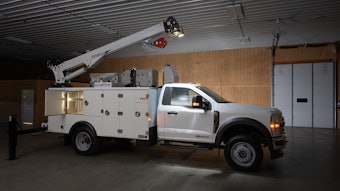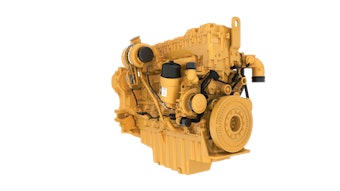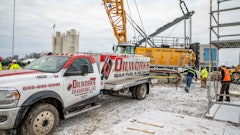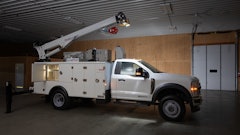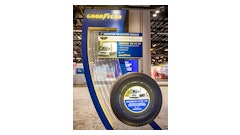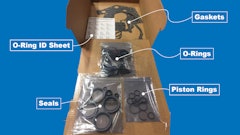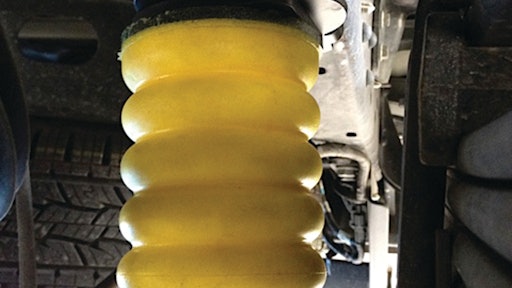
Helper springs are engineered to enhance and support the OEM suspension. They are most commonly available in two variants: steel springs and pneumatic springs. Helper springs serve several functions, including load leveling, increasing safety by offsetting the effects of heavy loads on vehicle handling and reducing maintenance costs by ensuring components are not overloaded.
The return on investment is twofold. No. 1 is safety. “A fleet or private business owner is always going to put safety before anything else,” says T.J. Miller, chief marketing officer, SuperSprings International. Next in line is the maintenance costs. “They are reducing the maintenance costs associated with the wear and tear caused by uneven loads.” This includes tire wear, brake wear, rotors wearing unevenly and really anything underneath the frame.
Firestone Industrial Products offers a full line of air helper springs. “Air springs are designed to maximize safe load carrying capacity, stability and overall ride quality,” says Paul Fessel, global light duty aftermarket channel manager. “Air springs improve vehicle handling when it is necessary to carry an uneven load, which allows for more effective braking, improved handling and a better ride quality. By alleviating fatigue on the suspension system, air springs also help improve tire wear life and reduce overall maintenance costs.”
SuperSprings International offers a full line of both steel helper springs and pneumatic springs. “Our products are specific to light- and medium-duty applications,” says Miller. “When you get into heavy-duty applications, things drastically change. Relevant to the light- and medium-duty applications, helper springs are a crucial part of a commercial application because the original equipment just wasn’t intended to do the tasks we ask our work trucks to do. We put uneven loads on them, such as cranes. We [add] weight all of the way up to the GVWR.” That can cause additional wear and tear on other components.
With helper springs, you achieve a longer lifespan from the original equipment. “It reduces the wear and tear,” says Miller. “And more importantly, it increases safety and reduces maintenance cost and downtime. A level load is a safe load. A truck that is sagging or an un-level load is just dangerous.” The helper springs are there to help stabilize the load and provide additional safety.
The benefits of helper springs are well recognized. “Everything from a contractor body to a service truck [with crane], to wreckers and tow trucks — you name a light- or medium-duty application and I can point you to an upfitter who is using our equipment as stock,” says Miller.
It’s important to note that while helper springs increase stability and safety, they do not actually increase the capacity limits set by the vehicle manufacturer. “There is absolutely no aftermarket product in the world that increases the GVWR of any vehicle,” Miller emphasizes. “The GVWR is set by the manufacturer. What we are doing within that payload range is as more weight is applied, we are going to help that stock suspension carry the weight in a safer and more reliable way.”
You will realize the benefits if you have a payload approaching the maximum GVWR, or have a side load, such as a crane, that causes the truck to lean toward one side.
Steel spring options
Steel helper springs come in several variants, including the add-a-leaf, which adds a steel spring to your existing leaf spring pack; the auxiliary spring, which can be added above or below the existing leaf spring assembly; or the helper spring system that includes steel springs in conjunction with some form of system. The steel spring options do not require any additional maintenance.
Yet, there are trade-offs with many helper spring solutions that must be considered to make the most appropriate choice. For instance, consider the add-a-leaf solution. While the addition of more steel springs to the existing leaf spring pack does offer more load support, it also changes the ride quality of the vehicle. Adding more leaf springs results in greater stiffness since the leaf spring is engaged all of the time, even when the truck is unloaded.
“Unloaded, your ride quality is going to be jeopardized,” says Miller. “Loaded up, it is probably going to be better. Most people automatically start thinking about the trade-off — the stiffness vs. the load capacity. What they don’t factor in and what we communicate to upfitters is the time to add a leaf if you have to take a truck to the shop. You need the spring shop to [disassemble] the leaf spring, add the leaf, reassemble and reinstall the leaf spring. Then you have to get it from the spring shop back to your shop. At a minimum, we have seen two and three days of downtime with trucks for add-a-leaf.”
Then there is the auxiliary spring option. These “overload springs” are attached to the main spring assembly and will take some of the load once the ends of the auxiliary spring make contact with the frame. Auxiliary springs do not assist with the load until the ends make this frame contact. Until that point, auxiliary springs are not used and add extra weight to the vehicle.
Helper spring systems, on the other hand, constantly help as weight is added to a vehicle. These systems can address a major drawback with add-a-leafs and auxiliary springs — a compromised unladen ride quality.
“Our company is unique in that we can provide a better ride,” says Miller. The company’s SuperSprings system is self adjusting. “As load is applied, rollers on the shackle flex out. They accommodate movement. Regardless of a smaller amount of weight or a larger amount of weight, the ride quality is going to be minimally affected.”
The installation is a bolt-on process that takes less than a day out of service.
Pneumatic options
Pneumatic solutions include inflatable air bag systems or hollow rubber core springs.
When it comes to air bag systems, there are many choices available. There are many ways to get air into the bag/bladder and the systems range in complexity from those that are manually inflated to those where the air pressure can be remotely adjusted from inside the cab. The challenges faced by these systems include air leaks and the potential for torn or ripped air bags.
“Air springs provide benefits to various types of vehicles on the road today, from heavy-duty trucks to trailers and buses,” says Fessel. “When determining if an air spring kit is a fit for a vehicle, customers should work closely with a trusted dealer or manufacturer to assess the vehicle’s condition, purpose and need to ensure the purchased helper spring is the right fit... There are also many resources available online to assist in the selection process. For example, Firestone Industrial Products provides customers with an easy to use Kit Search Tool (available on its website) to determine which product fits a certain vehicle.”
The air springs prevent premature suspension wear. “When a vehicle’s suspension is worn, there are direct impacts on tire wear and, as such, gas mileage,” explains Fessel. “Air springs are engineered to diminish fatigue on a vehicle’s suspension system, which allows for better handling and a smoother ride quality. When the suspension system is heavily loaded, tires and brake pads are pushed to their full potential, causing fleet owners to repair and replace more often. By using air springs, drivers are opting for more efficient gas mileage and a lower total cost of ownership.”
Air springs adapt to the load. “The purpose of air helper spring kits is to improve the loaded vehicle conditions so there are no penalties when vehicles are unladen,” says Fessel. “Typically, air spring kits solely serve to assist a vehicle’s suspension when the vehicle is loaded and, as such, do not affect the vehicle’s manufacturer warranty.”
You do have to ensure your vehicle is compatible with an air spring kit. “Most air spring kits are uniquely designed based on a vehicle’s year, make and model, as they are installed between the frame of the vehicle and the suspension system, which varies between vehicle types,” notes Fessel. “Though universal across each specific vehicle year, make and model, air spring kits often offer multiple spring combinations that can provide the tailoring to fit individual needs. To give further control of an individual ride, Firestone Industrial Products offers Air-Rite Air Command Systems that allow drivers to adjust their ride for various load and road conditions with the flip of a switch, the click of a remote or even by using an app on a mobile device.”
The other options for pneumatic helper springs are hollow rubber core springs and micro-cellular urethane springs. SuperSprings offers a product called SumoSprings that contain millions of microscopic air bubbles enclosed in urethane. “It is very similar to an air bag but very different,” says Miller. “They have superior damping qualities when even compared against the traditional air bag. They actually smooth out the ride.”
Unlike an air bag, the micro-cellular urethane springs do not require compressed air. “They don’t pop. They don’t leak. There is literally no maintenance,” says Miller.
Make sure the suspension is properly balanced
A properly designed helper spring system does more than stiffen the rear springs. “We always describe suspension systems as a holistic system with the front and rear working together,” says Miller. “It is not going to become stable until you support all four corners.”
If you support the rear end to eliminate sag but do not support the front, the truck will not be stable when the weight shifts forward during braking, turning or hitting an expansion joint.
“We always recommend if you are going to put a helper spring in the back, put something like SumoSprings or Coil SumoSprings in the front,” says Miller. This prevents all of the stress being transferred to the original coils when the weight shifts forward.
Select the best fit
You must understand what you are trying to achieve in order to pick the right helper spring solution.
“If you have a concern about ride quality, then you really should lean toward the air springs, the SumoSprings, in our product line,” says Miller. If you are more concerned with how much weight the helper spring can level out, you should lean toward the steel. “We can make steel a lot bigger and a lot stronger than an air spring. So when it comes to a medium-duty application that is under load constantly, I will almost always default to the steel helper spring system.
“When we are talking light- and medium-duty applications of variable loads, like a contractor, I almost always default to the air spring,” says Miller. “The beauty of the SumoSprings is it is a progressive spring. So when [the vehicle is] under load and pressure is being applied to the spring when it is being compressed, the more it compresses, the more it is going to resist. It will support the load when the load is applied, and it will be there as a damper or a shock absorber when the load isn’t there.”


